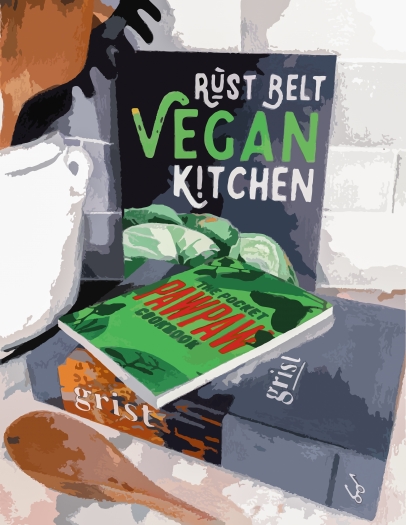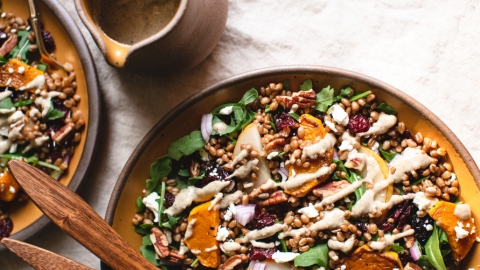Midwest Fresh
These three notable cookbooks from 2021 all have ties to our region, though otherwise they could hardly be more different. One emerges from the Promethean imagination of a local powerhouse chef, one is a community cookbook with vegan recipes from professional and home cooks, and one explores a unique niche in our Midwestern flora.
Grist: A Practical Guide to Cooking Grains, Beans, Seeds, and Legumes
By Abra Berens
Chronicle Books
Grist is above all a book of ideas. It is scientific and personal, philosophical and practical, wise and funny. Recipes for every type of grain, legume and seed are presented with at least three variations to accommodate the changing seasons and the state of your pantry.
Detailed research explores the plant families’ botanical structures and protein levels as well as their global and historical origins. Scattered throughout are interviews with the farmers and others who grow and process our food, along with ideas about justice, sustainability and health.
A former farmer, Berens is executive chef at Granor Farm in Three Oaks, Michigan, and author of the 2019 cookbook Ruffage: A Practical Guide to Vegetables, a James Beard award nominee. Turning her attention to a new food category in Grist, she applies the same Midwestern perspective, knowledge of ingredients and wide-ranging imagination.
Continued on page 26
Chicken and Wild Rice Soup with Kale and Tomato Paprika Mayo
By Abra Berens
Grist: A Practical Guide to Cooking Grains, Beans, Seeds, and Legumes
Serves 6–8
It sounds terrible to float mayonnaise in a soup—at least that’s what I thought when I read a recipe for French fish stew finished with rouille, a red pepper mayo traditional in Provence. Turns out it isn’t gross, unless you don’t like mayo, in which case consider turning your head when you scoop it into the soup bowl and give it a stir; within 30 seconds it will have melted, and the soup (and life) will be better.
Neutral oil
2 onions (about 1 pound), thinly sliced
6 cloves garlic, minced
Salt and freshly ground black pepper
1 cup white wine or hard cider
1 pound carrots, diced
1½ cups wild rice, soaked or unsoaked
8 cups chicken stock
2 boneless, skinless chicken breasts (about 1 pound), sliced into strips
10 leaves any variety of kale, leaves stripped from the stems and cut into ribbons
¼ cup Cherry Tomato Conserva or 2 tablespoons tomato paste
1 recipe Tomato Paprika Mayo
In a soup pot, heat a glug of neutral oil over medium heat. Add the onion and garlic with a big pinch of salt and a couple of grinds of black pepper and sweat until tender, about 7 minutes. Add the wine and cook until almost evaporated, about 3 minutes.
Add the carrots and wild rice and stir to combine and briefly toast. Add the chicken stock and bring to a boil, then lower the heat and simmer until the rice is tender, about 25 minutes for soaked and 50 for unsoaked.
When the rice is tender, add the chicken breasts to the soup. Drop in one slice at a time—if you plunk the whole pile in together, the slices might fuse back together as the proteins constrict. Poach until the chicken is cooked through, 5 minutes or so.
To serve, portion the kale into soup bowls and ladle the soup over the kale, allowing it to wilt gently. Combine the conserva and mayo in a small bowl and blend until smooth. Spoon a couple of dollops of the conserva mayo on top of each bowl.
Tomato Paprika Mayo
1 egg
1 lemon (about 11/2ounces), zest and juice
1 teaspoon smoked paprika
½ teaspoon salt
12 ounces neutral oil
¼ cup Cherry Tomato Conserva or 2 tablespoons tomato paste
In a food processor, combine the egg, lemon zest and juice, paprika and salt and whiz to blend. Drizzle in the oil to make a thick mayo. When the mayo is thick, add the conserva and blend until smooth. Store in the refrigerator.
Cherry Tomato Conserva
5 pounds cherry tomatoes
Olive oil
Salt
Preheat the oven to 350°. Toss the tomatoes with several glugs of olive oil and pinches of salt.
Transfer to an ovenproof baking dish and bake the tomatoes, stirring every 20 minutes or so. The larger the baking dish, the more surface area you’ll have to evaporate the liquid, so the faster they will cook. Bake until the tomatoes burst and the liquid reduces until thick enough to drag a spoon across the baking dish and not have the liquid run into the path of the spoon, about 40 minutes.
Cherry Tomato Conserva freezes perfectly.
EM editor’s note: We found in testing that 11/2 pounds of cherry tomatoes baked in a 9- by 13-inch pan reduced perfectly in the amount of time indicated and was just the right amount for the soup recipe.
Reprinted from Grist: A Practical Guide to Cooking Grains, Beans, Seeds, and Legumes by Abra Berens with permission from Chronicle Books, 2021.
The chapter on barley is a typical example. It starts with a musing on the inherent, life-giving magic of seeds, followed by ideas for “a week’s worth of barley without any boredom.” Berens suggests a “prep the ingredient instead of the dish” approach to meal planning. Start the week by boiling a big pot of barley, then marinate it for a salad, fry it for texture over a vegetable, make soup and porridge and cakes (with lamb chops on top) from it.
The globally inflected condiments of the first chapter—vinaigrettes, mayos, spice mixes, mojos, rigs and relishes, and so on—enrich the rest of the dishes in the book. One of Berens’s foremost talents is layering flavors in unexpected, delicious ways. Topping a simple split pea soup with balsamic vinegar, chili oil and sour cream is a revelation (she calls it “modern Midwestern”), as is borrowing the French bouillabaisse technique of floating flavored mayonnaise in soup for her chicken and wild rice soup with kale (see recipe, page 25).
Berens offers a wealth of inspiration for these food families and encourages us to start experimenting, substituting and adapting them to our personal tastes. The recipes are intentionally loose, so be prepared to apply your own kitchen experience. Start with an ingredient you love, then try one you’ve never heard of. “I believe comfort begets confidence, and confidence begets courage,” Berens writes. Words for life.
Rust Belt Vegan Kitchen
Edited by Meredith Pangrace Belt Publishing
Being a Midwest vegan presents challenges: A short growing season means limited local produce for much of the year, and many regional favorites are heavy on meat and dairy. In Rust Belt Vegan Kitchen, Meredith Pangrace has created a community cookbook drawing on ideas from professional chefs, food writers, farmers and home cooks about making it work. They bring with them stories about choosing veganism, the comfort foods of their childhoods and how they adapt recipes to bring heritage dishes to their current lifestyle.
Pangrace writes, “These dishes aren’t the avocado-and-sprout spa menu meals of the West Coast. The vegan food of the Rust Belt offers comfort and brews nostalgia.”
The book reflects the region’s diverse population, due to historical and more recent immigration. There are recipes for everything from Slovakian palacinky (sweet crepes) and West African peanut soup to paprikash, stuffed cabbage, and cauliflower and chickpea masala. Dishes range from the complex, such as Mole de Xico on Roasted Chayotes, with its long list of peppers, nuts and spices, to a Jiffy Corn casserole that lives up to its name.
Many of the recipes take a traditionally meat-based dish and transform it; among those, two approaches emerge.
Mac & Cheese
By John Hagerty
Rust Belt Vegan Kitchen
Serves 6
1 pound cavatappi pasta
1½ medium carrots, diced
½ potato, diced
½ yellow onion, diced
½ red bell pepper, seeded and diced
1 cup raw cashews
4 cloves garlic
½ can unsweetened coconut milk
1½ tablespoons kosher salt
¼ tablespoon coarse ground black pepper
1 tablespoon paprika
½ tablespoon hot sauce
½ teaspoon turmeric
2 cups water
Juice of ½ lemon
1½ cups nutritional yeast
Cook pasta according to the package instructions. Combine all ingredients except the nutritional yeast into a large saucepan or pot. Simmer for 20 minutes or until cashews and veggies are tender. Stir in the nutritional yeast and let it simmer another minute or so as it dissolves.
Puree with a high-speed blender or stick blender. The sauce should be loose with a velvety texture. If the sauce seems too thick, stir in more water slowly until desired consistency is reached. Season with more salt, pepper and hot sauce to taste.
Pour over the cooked pasta and gently stir. Start with 2 cups, then add more to desired level of sauciness. Save the remaining sauce for dipping pretzels, pouring over vegetables or making nachos.
RBVK tip: Store leftover mac in the refrigerator, then reheat leftovers on the stove, stirring in a bit of plant-based milk and leftover sauce for moisture. Reheating in the oven or microwave will dry it out too much, and the beauty of this recipe is that creamy, velvety sauce.
EM editor’s note: We found in testing this recipe that smoked paprika overwhelms the flavor of the sauce, so we recommend a sweet, bright variety.
Some offer a quick swap with a meat- or dairy-substitute product. Italian wedding soup calls for a bag of plant-based meatballs and faux Parmesan cheese, and Cleveland-style Polish Boy starts with vegan sausages. Pangrace explains that readers will notice “several unpretentious shortcuts, because in true Midwestern fashion, we admit that sometimes we just can’t do it all.”
Other recipes offer ingenious workarounds to the exclusions. Baked goods use egg substitutes like aquafaba and chia and flax eggs. Cincinnati Chili calls for a scratch-made lentil-quinoa ground meat substitute, and tofu skins stand in for chitterlings in a soul food classic. The main ingredient in fishless tacos is fried eggplant.
Useful sections at the start of the book include “Make it/Buy it,” which explains how to whip up plant-based substitutes such as tofu cream cheese and aquafaba mayo at home, and a pantry staples list to facilitate vegan meal-making. Enough to pique the curiosity of even a committed omnivore!
The Pocket Pawpaw Cookbook
By Sara Bir
Belt Publishing
The pawpaw—also known as the Indiana banana, redneck banana and hillbilly mango—is having a moment. A growing interest in regional wild foods has spurred a new generation to discover the pleasures of foraging for this forest treasure hidden in plain sight.
Sara Bir, author of the IACP Cookbook Award–winning The Fruit Forager’s Companion, is an ideal guide to the pursuit. Her Pocket Pawpaw Cookbook is a gem, written with humor and flights of fancy as well as ecological, scientific and practical considerations.
The pawpaw is an ancient fruit, present in North America before humans were. “Asimina triloba is the most northerly-growing member of the Annonaceae, or custard apple, family,” Bir explains. Prehistoric mammals likely carried the seeds north and the plants adapted into a staple of indigenous peoples’ diets.
Baked Pawpaw Pudding
By Sara Bir
The Pocket Pawpaw Cookbook
Serves 6–8
This is an old-fashioned baked pudding, not as creamy as custard but smooth and rich, with intriguing caramel notes and an undeniable pawpaw kick. Pawpaw pudding is extremely similar in texture to pumpkin pie filling, and as a bonus, you don’t have to mess with a crust. With a food processor, it takes only minutes to blitz the batter together.
2/3 cup (93 grams) unbleached all-purpose flour
2/3 – ¾ cup sugar
¼ teaspoon table salt
½ teaspoon baking soda
1 cup pawpaw pulp
½ cup buttermilk
¼ cup half-and-half
1 large egg
1 large egg yolk
2 teaspoons vanilla bean paste or vanilla extract
3 tablespoons unsalted butter, melted and cooled
Heat the oven to 350° and position a rack in the middle. Grease an 8- by 8-inch baking dish, preferably glass or ceramic.
In the bowl of a food processor, pulse the flour, sugar, salt and baking soda to combine.
In a large glass measuring cup or medium bowl, combine the pawpaw, buttermilk, half-and-half, egg and egg yolk and vanilla. With the food processor running, add the pawpaw-buttermilk mixture through the feed tube. Turn off the machine, scrape down the sides of the bowl, and add the melted butter with the machine running. The batter should have the consistency of pancake batter.
Pour the batter into the greased dish. Bake until the center is set but still jiggly (like a pumpkin pie), about 35 to 45 minutes. As it bakes the pudding may puff up, then deflate—this is normal. The edges will brown and the center will be flat, shiny and amber-colored.
Set on a wire rack to cool (the pudding will collapse as it cools). Serve at room temperature with crème fraîche or whipped cream.
The pudding will keep 2 to 3 days at room temperature.
Make this gluten-free: Use cup white rice flour in place of the all-purpose flour.
EM editor’s note: Nektar Flow Farms in Peru, Indiana, provided pawpaw pulp for our testing. Their fruit is available in season at Maple City Market in Goshen and Purple Porch Co-op in South Bend, among other places. Find them on Facebook to order frozen pulp year-round.
Bir explains how and when to forage for pawpaws and what to look for. In a section titled “How To Eat a Pawpaw In The Woods,” she writes that once you find the greenish-yellow fruit, “You can, and should, tear it apart with your hands. The tender flesh will be pale yellow to deep saffron. The aroma will let you know if it’s ready to eat. It will offer sensations of mango/ banana/citrus/pineapple in combinations you’ve not experienced before. It will hold large, dark, gleaming seeds.”
Contrary to the childhood song, it’s not a good idea to put a pawpaw in your pocket, since they bruise easily. This explains their lack of commercial exploitation, along with a short shelf life and growing season. Some producers, however, have started to offer frozen pulp year-round; they are helpfully listed, among other resources, at the back of the book.
Bir details how to process your pawpaw haul and what to cook with it. She provides a flavor key for her recipes, in which each is rated on a scale from one pawpaw (“a hint of pawpaw flavor”) to three (“whoa, pawpaw!”).
The range of recipes is surprising, from haute cuisine (pawpaw beurre blanc) to nostalgic mall food (pawpaw Julius). There are sweet treats like ice cream, panna cotta, cheesecake and caramel sauce, and savory preparations including corn bread, beer cheese and Porkchops with Mustard Pawpaw Cream Sauce. Pawpaw adds its unique flavor to a number of condiments, such as mayo, ketchup, habanero hot sauce and mustard barbecue sauce, and to drinks like a creamy lassi or a fizzy Bellini.
Another great reason to head out to the woods this summer…
Lisa Barnett de Froberville is a French teacher and translator and the managing editor of Edible Michiana.









